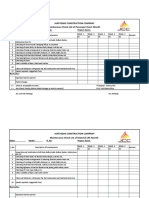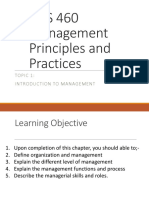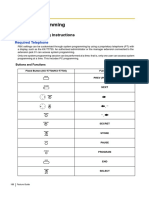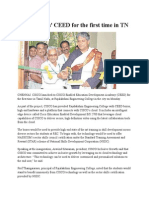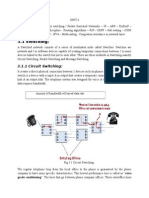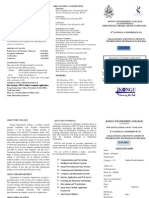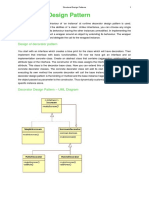Introduction To MGT
Introduction To MGT
Uploaded by
lghmshariCopyright:
Available Formats
Introduction To MGT
Introduction To MGT
Uploaded by
lghmshariOriginal Description:
Original Title
Copyright
Available Formats
Share this document
Did you find this document useful?
Is this content inappropriate?
Copyright:
Available Formats
Introduction To MGT
Introduction To MGT
Uploaded by
lghmshariCopyright:
Available Formats
METHODS OF ASSESSMENT
Attendance 05
Quizzes, Case Study, etc 15
Seminar & exam 20
Final exam 60
Total 100
Reference Books:
1. Essentials of Management
Harold Koontz & Heinz Weihrich
2. Management
Heinz Weihrich, Mark V Cannice, Harold
Koontz
3. Management
By James Arthur Finch Stoner, Freeman R, Jr
Gilbert Daniel R
By the end of today's session you will
understand
1) Why learn Management, What is Management?
2)Meaning, definition, objectives and importance of
Management
3) Nature of Management
4)Functions of Management
5) Who are managers?
6) Role of Managers, Managerial skills
Why study this subject?
1)To understand the process of business
management and its functions, and
2) To familiarize the students with current
management practices. .
3) To understand the importance of ethics in
business, and
4) To acquire knowledge and capability to
develop ethical practices for effective
management.
Introduction to
Management
Chapter
1
Why Study
Management?
Need for Management?
Who Are Managers?
Manager
Someone who coordinates and oversees the work of
other people so that organizational goals can be
accomplished.
Definition of Management:
Management is the process of designing
and maintaining an environment in which
individuals, working together in groups,
efficiently accomplish selected aims.
What Is An Organization?
An Organization Defined
A deliberate arrangement of people to accomplish some
specific purpose (that individuals independently could
not accomplish alone).
Common Characteristics of Organizations
Have a distinct purpose (goal)
Composed of people
Have a deliberate structure
Managerial Concerns:
Efficiency
Doing things right
Getting the most output for the
least inputs
Effectiveness
Doing the right things
Attaining organizational goals
Management Strives For:
Low resource waste (high efficiency)
High goal attainment (high effectiveness)
Resource
Usage
Efficiency (Means)
Goal
Attainment
Effectiveness (Ends)
Low Waste High Attainment
Efficiency and Effectiveness in Management
113
Managers have to cope with diverse and far-
reaching challenges
1. To keep pace with ever-advancing technology
2. To find ways to incorporate the Internet and e-
business into their strategies and business model
3. Strive to remain competitive in a dynamic and
far reaching world
Managerial Levels
Middle Line Managers
Top Line
Managers
First Line Managers
Non Managerial Employees
Levels of Management
CEO
COO
CIO
General Mgr
Plant Mgr
Regional Mgr
Office Manager
Shift Supervisor
Department Manager
Team Leader
Top Level Management
Middle Level Management
First-Line
Management
Top Managers
Responsible for
Creating a context for change
Developing attitudes of commitment
and ownership in employees
Creating a positive organizational
culture through language and action
Monitoring their business environments
Middle Managers
Responsible for
Setting objectives consistent with top
management goals, planning strategies
Coordinating and linking groups,
departments, and divisions
Monitoring and managing the performance
of subunits and managers who report to them
Implementing the changes or strategies
generated by top managers
First-Line Managers
Responsible for
Managing the performance of
entry-level employees
Teaching entry-level employees
how to do their jobs
Making schedules and operating plans based on
middle managements intermediate-range plans
Management Levels and Functional Areas
Types of Managers
General Managers
Supervise the activities of several departments.
Functional Managers
Supervise the activities of related tasks.
Common functional areas:
Marketing
Operations/production
Finance/accounting
Human resources/personnel management
Project Managers
Coordinate employees across several functional departments to
accomplish a specific task.
What Do Managers Do?
Functional Approach
Planning
Defining goals, establishing strategies to
achieve goals, developing plans to integrate
and coordinate activities.
Organizing
Arranging and structuring work to accomplish
organizational goals.
Leading
Working with and through people to
accomplish goals.
Controlling
Monitoring, comparing, and correcting work.
Resources
Human
Financial
Raw Materials
Technological
Information
Performance
Attain goals
Products
Services
Efficiency
Effectiveness
Leading
Use influence to
motivate employees
Planning
Select goals and
ways to attain
them
Organizing
Assign responsibility
for task
accomplishment
Controlling
Monitor activities &
make corrections
What Do Managers Do? (contd)
Skills Approach
Technical skills
Knowledge and proficiency in a specific field
Human skills
The ability to work well with other people
Conceptual skills
The ability to think and conceptualize about
abstract and complex situations concerning
the organization
Skills @ Different Management Levels
Managerial Roles Approach (Mintzberg)
Managers play various roles as necessary while performing their
management functions so as to achieve organizational objectives.
What Companies Look for in Managers
Technical
Interpersonal
Conceptual
Diagnostic
Communication
Decision-Making
Time-Management
New Workplace Issues and Challenges
Technology and Speed
Globalization
and Diversity
Knowledge,
Learning,
Quality, and
Continuous
Improvement
Change, Creativity, Innovation,
and Entrepreneurship
Participative
Management,
Empowerment,
and Teams
Knowledge
Management
Ethics and
Social
Responsibility
Networking and
Boundaryless
Relationships
14 PRINCIPLES OF
MANAGEMENT
1. Division of Labor
2. Authority &
Responsibility
3. Unity of Command
4. Unity of Direction
5. Equity
6. Order
7. Discipline
8. Initiative
9. Remuneration
10. Stability of
Tenure
11. Scalar Chain
12. Sub-Ordination of Individual
Interest to common goal
13. Espirit De Corps
14. Centralization
You might also like
- The World of Innovative ManagementDocument23 pagesThe World of Innovative ManagementNoor DeenNo ratings yet
- Laptop Chip Level CourseDocument2 pagesLaptop Chip Level CourselghmshariNo ratings yet
- Electrical Drives and Control - Unit-I (MECHANICAL ENGINEERING)Document83 pagesElectrical Drives and Control - Unit-I (MECHANICAL ENGINEERING)Thivya PrasadNo ratings yet
- Equipement Checklist (Hoist & Lift)Document2 pagesEquipement Checklist (Hoist & Lift)Bapusaheb Guthale100% (1)
- Attendance 05 Quizzes, Case Study, Etc 15 Seminar & Exam 20 Final Exam 60 Total 100Document31 pagesAttendance 05 Quizzes, Case Study, Etc 15 Seminar & Exam 20 Final Exam 60 Total 100KNRavi KiranNo ratings yet
- Hospital Management Lec 1Document42 pagesHospital Management Lec 1hosam nabilNo ratings yet
- Lecture 1Document78 pagesLecture 1tushargarg9905No ratings yet
- Introduction To Management: Know How To Manage Your Time. Develop Your Skill at Being Politically AwareDocument34 pagesIntroduction To Management: Know How To Manage Your Time. Develop Your Skill at Being Politically Awaremubasher100% (1)
- Management Chapter 1 Fall 10-11Document30 pagesManagement Chapter 1 Fall 10-11Geryes E. HaddadNo ratings yet
- FB ManagmentDocument225 pagesFB ManagmentHtetThinzarNo ratings yet
- Arts Faculty Introduction To MGTDocument63 pagesArts Faculty Introduction To MGTAhamed AmeenNo ratings yet
- Files 2 Lectures Chapter 1Document44 pagesFiles 2 Lectures Chapter 1Amit KumarNo ratings yet
- Introduction To Management & OrganizationsDocument10 pagesIntroduction To Management & OrganizationsAkiNiHandiongNo ratings yet
- Chapter1 RobbinsDocument7 pagesChapter1 Robbinsa drunk manNo ratings yet
- Management Unit-1 IntoductionDocument44 pagesManagement Unit-1 IntoductionSunil JoshiNo ratings yet
- Unit 1 Management PrinciplesDocument54 pagesUnit 1 Management PrinciplesAhmad KhanNo ratings yet
- Management Lecture 1Document37 pagesManagement Lecture 1LolNo ratings yet
- Management: Introduction To Management and OrganizationsDocument18 pagesManagement: Introduction To Management and Organizationsitin_doNo ratings yet
- M&E One and A Half ModuleDocument197 pagesM&E One and A Half ModuleAnanya GowdaNo ratings yet
- Management Theory and PracticeDocument20 pagesManagement Theory and PracticeSrinivas ShinuNo ratings yet
- Week 11 & 12-2Document41 pagesWeek 11 & 12-2Shehzad AhmadNo ratings yet
- Introduction To ManagementDocument18 pagesIntroduction To ManagementSakif Tasawer Sonto (173014038)No ratings yet
- Industrial Management FST 2210: S.P. NgwaruDocument46 pagesIndustrial Management FST 2210: S.P. Ngwarumatthew matawoNo ratings yet
- ADS 460 Management Principles and Practices: Topic 1: Introduction To ManagementDocument33 pagesADS 460 Management Principles and Practices: Topic 1: Introduction To ManagementNURATIKAH BINTI ZAINOL100% (1)
- Foundations of Management and OrganizationsDocument18 pagesFoundations of Management and OrganizationsCaroline Rebecca DNo ratings yet
- ch1 - Introduction - To - Management - and - OrganizationsDocument27 pagesch1 - Introduction - To - Management - and - Organizationsnimrakanwal070No ratings yet
- 1.-PrinciplesofManagement 01 IntroductiontoManagementDocument33 pages1.-PrinciplesofManagement 01 IntroductiontoManagementVirgelio Sayson AbesNo ratings yet
- Chapter1 2Document24 pagesChapter1 2mill68604No ratings yet
- Management:: Introduction To Management and OrganizationsDocument37 pagesManagement:: Introduction To Management and OrganizationsSteve MartinNo ratings yet
- Introduction To Management: Chapter 1 Stephen P. RobbinsDocument28 pagesIntroduction To Management: Chapter 1 Stephen P. RobbinsIbrahim FarooqNo ratings yet
- Lecture 1-Introduction To ManagementDocument30 pagesLecture 1-Introduction To ManagementOmar ElkadyNo ratings yet
- 1 Introduction To Bus. ManagementDocument66 pages1 Introduction To Bus. ManagementAizhan BaimukhamedovaNo ratings yet
- MBA Remedial I - Chapter 1 - Management & OrganizationsDocument16 pagesMBA Remedial I - Chapter 1 - Management & OrganizationsMajed ArkadanNo ratings yet
- Management: Concept, Role & PrincipalsDocument38 pagesManagement: Concept, Role & PrincipalsBilal HanifNo ratings yet
- chapter 1 Basics of Management and OrganizationsDocument38 pageschapter 1 Basics of Management and OrganizationsDaniel GetachewNo ratings yet
- GBS 550 Lecture Notes-Intro To Management 2019Document35 pagesGBS 550 Lecture Notes-Intro To Management 2019John SivileNo ratings yet
- Week 1 CH 1 Intro To MGTDocument26 pagesWeek 1 CH 1 Intro To MGTMuhammad SarmadNo ratings yet
- Acharya Institute of Management & SciencesDocument85 pagesAcharya Institute of Management & SciencesPradeepNo ratings yet
- COURSE: Management Concepts & Practices: Course Code - CP-101 MBA 2023-24Document73 pagesCOURSE: Management Concepts & Practices: Course Code - CP-101 MBA 2023-24mayurqnaNo ratings yet
- Introducton - Principles of Management: Managing in A Dynamic EnvironmentDocument55 pagesIntroducton - Principles of Management: Managing in A Dynamic EnvironmentRajashree KiniNo ratings yet
- General MANAGEMENT: Dr. Khin Marlar Maung Professor Department of Commerce Meiktila University of EconomicsDocument31 pagesGeneral MANAGEMENT: Dr. Khin Marlar Maung Professor Department of Commerce Meiktila University of EconomicsThoon ThoonNo ratings yet
- Introduction To ManagementDocument55 pagesIntroduction To ManagementM ManjunathNo ratings yet
- A 2023 Principles of ManagementDocument19 pagesA 2023 Principles of ManagementAnonymously MKNo ratings yet
- Session 1Document65 pagesSession 1John RayNo ratings yet
- Introduction To Management - CH 1Document34 pagesIntroduction To Management - CH 1efremwubetu9No ratings yet
- What Is ManagmentDocument3 pagesWhat Is ManagmentHanan MurtazaNo ratings yet
- Principles of Management Chapter 01 QuyDocument38 pagesPrinciples of Management Chapter 01 QuyThảo An TrịnhNo ratings yet
- Module-I-Intro-Mgmt - StdsDocument51 pagesModule-I-Intro-Mgmt - Stdspraptipandya89No ratings yet
- Chapter 1Document26 pagesChapter 1AmirCPNo ratings yet
- Topic 4 The Nature of ManagementDocument37 pagesTopic 4 The Nature of Managementyingg0116No ratings yet
- Principles of ManagementDocument59 pagesPrinciples of ManagementTehreem SyedNo ratings yet
- Chương 1 - A - IntroductionDocument39 pagesChương 1 - A - Introductiondatmaziu21No ratings yet
- Unit 01 Introduction To Management - NewDocument26 pagesUnit 01 Introduction To Management - Newk58 Duong Thi HangNo ratings yet
- INTRODUCTION TO MANAGEMENT-1Document11 pagesINTRODUCTION TO MANAGEMENT-1stevenkatias11No ratings yet
- Week1 - Introduction To ManagementDocument26 pagesWeek1 - Introduction To ManagementJoan AntonioNo ratings yet
- ch-1 (Introduction)Document46 pagesch-1 (Introduction)Azhar KhanNo ratings yet
- Principles OF Management: Presented By: Aniruddh SharmaDocument25 pagesPrinciples OF Management: Presented By: Aniruddh Sharmaashutosh002No ratings yet
- Week1 - Introduction To ManagementDocument26 pagesWeek1 - Introduction To ManagementJoan AntonioNo ratings yet
- Chapter 1 PPTDocument26 pagesChapter 1 PPTRk SharafatNo ratings yet
- Management OrganizationDocument29 pagesManagement Organizationrerom54931No ratings yet
- Steve Jobs Bill Gates Mark ZuckerbergDocument30 pagesSteve Jobs Bill Gates Mark ZuckerbergAhsan MalikNo ratings yet
- Basic Management Techniques: DP World 11-13 October 2015Document72 pagesBasic Management Techniques: DP World 11-13 October 2015Ahmad FaroukNo ratings yet
- Business Management Principles for Today's Leaders: A Practical Guide for ProfessionalsFrom EverandBusiness Management Principles for Today's Leaders: A Practical Guide for ProfessionalsNo ratings yet
- SCH 5127Document290 pagesSCH 5127lghmshariNo ratings yet
- Securico SensorDocument52 pagesSecurico Sensorlghmshari100% (2)
- PanasonicDocument69 pagesPanasoniclghmshariNo ratings yet
- ADocument10 pagesAlghmshariNo ratings yet
- 3A L.D.O. VOLTAGE REGULATOR (Adjustable & Fixed) LM1085: FeaturesDocument8 pages3A L.D.O. VOLTAGE REGULATOR (Adjustable & Fixed) LM1085: FeatureslghmshariNo ratings yet
- Securico SensorDocument52 pagesSecurico Sensorlghmshari100% (2)
- Syllabus 120Document9 pagesSyllabus 120lghmshariNo ratings yet
- Treatment Guide For Homeopathy PDFDocument79 pagesTreatment Guide For Homeopathy PDFlghmshariNo ratings yet
- Rethinking Permission GrantingDocument15 pagesRethinking Permission GrantinglghmshariNo ratings yet
- UFace 602 ManualDocument75 pagesUFace 602 ManuallghmshariNo ratings yet
- CISCO 'Sows' CEED For The First Time in TNDocument2 pagesCISCO 'Sows' CEED For The First Time in TNlghmshariNo ratings yet
- HitachiDocument4 pagesHitachilghmshariNo ratings yet
- Sy 8 AuthorsDocument58 pagesSy 8 Authorslghmshari0% (1)
- Castro HandoutsDocument12 pagesCastro HandoutslghmshariNo ratings yet
- Unit 3 UpdatedDocument68 pagesUnit 3 UpdatedlghmshariNo ratings yet
- All HR HeadsDocument138 pagesAll HR HeadsGurnaamSinghNo ratings yet
- Conference Mca KONGUDocument2 pagesConference Mca KONGUlghmshariNo ratings yet
- General Knowledge Objective QuizDocument234 pagesGeneral Knowledge Objective Quizlghmshari100% (1)
- SHP Homeopathy As A Treatment For HIV and Aids Session 1Document14 pagesSHP Homeopathy As A Treatment For HIV and Aids Session 1lghmshari100% (1)
- Quiz QuestionsDocument5 pagesQuiz QuestionsShreeshNo ratings yet
- Sri Chaitanya Educational Institutions, India.: Important InstructionsDocument24 pagesSri Chaitanya Educational Institutions, India.: Important Instructionsbal_thakreNo ratings yet
- Balcao DetailDocument1 pageBalcao DetailmatrejajinaNo ratings yet
- Clinic System SRSDocument14 pagesClinic System SRSAshraf Sayed AbdouNo ratings yet
- The Doors - Touch MeDocument23 pagesThe Doors - Touch MeDiego David Novoa GuillenNo ratings yet
- Comyn GenealogyDocument13 pagesComyn GenealogyJeff MartinNo ratings yet
- Error SpottingDocument3 pagesError SpottingselvambhrNo ratings yet
- BS en 13565-2-2018 (2019)Document50 pagesBS en 13565-2-2018 (2019)AntonijeNo ratings yet
- Pure Substances and MixturesDocument6 pagesPure Substances and MixturesAIDYN TVNo ratings yet
- PIPELINEDocument17 pagesPIPELINErishateachaNo ratings yet
- Chapter 10 Justice and FairnessDocument22 pagesChapter 10 Justice and FairnessFallaria Paulo A.No ratings yet
- VoucherDocument1 pageVoucherKsks KsksNo ratings yet
- Relational ModelDocument3 pagesRelational ModelRuslanas GailiusasNo ratings yet
- Basic Concept Method:: Flexural Stresses: Second Moment of Inertia, IDocument6 pagesBasic Concept Method:: Flexural Stresses: Second Moment of Inertia, IJeremiah VillanuevaNo ratings yet
- Lesson 5 TheoremDocument5 pagesLesson 5 TheoremMonique NewenNo ratings yet
- DS 124 9162000+Smoke+Signal+Orange+Iss2Document2 pagesDS 124 9162000+Smoke+Signal+Orange+Iss2Benjamin StricklandNo ratings yet
- Sat Sleeve Hotspot User ManualDocument115 pagesSat Sleeve Hotspot User Manualkapiw45478No ratings yet
- SEW Compact Constant Speed Reducer MC SeriesDocument195 pagesSEW Compact Constant Speed Reducer MC SeriesDênis DáyolNo ratings yet
- Handout - Mathematical Language and SymbolsDocument8 pagesHandout - Mathematical Language and Symbolsmaricon alaskaNo ratings yet
- Notes On ODDocument18 pagesNotes On ODMona GavaliNo ratings yet
- Download Innovative Houses Concepts for Sustainable Living 1st Edition Avi Friedman ebook All Chapters PDFDocument50 pagesDownload Innovative Houses Concepts for Sustainable Living 1st Edition Avi Friedman ebook All Chapters PDFpyrahgroppg7100% (4)
- Ashok Singh Topic 3Document9 pagesAshok Singh Topic 3Insta viralNo ratings yet
- Assistant Executive EngineeringDocument3 pagesAssistant Executive Engineeringsearch_omegaNo ratings yet
- Structural Design PatternDocument34 pagesStructural Design PatternAkula SandeepNo ratings yet
- Upload 5 Documents To Download: IATA Airport Handling Manual ContentsDocument3 pagesUpload 5 Documents To Download: IATA Airport Handling Manual ContentsKetan JayswalNo ratings yet
- Mid Term Exam - FE 63 240226Document3 pagesMid Term Exam - FE 63 240226Mai AnhNo ratings yet
- Mental Models I Find Repeatedly Useful - by Gabriel Weinberg - MediumDocument34 pagesMental Models I Find Repeatedly Useful - by Gabriel Weinberg - MediumVladimir OlefirenkoNo ratings yet



